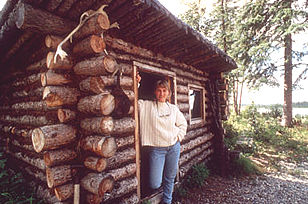The following is a greeting given in one of the 20 indigenous languages recognized by the State of Alaska.
- Ade’ ndadz dengit’a?
- Language: Deg Xinag
- Translation: "Hello, how are you?"
Homesteading
Homesteading
|
Since the 1986 repeal, there has been no federal homesteading program in Alaska; the State of Alaska, however, created public land disposal programs starting with statehood in 1959. Initially, the state sold land primarily through auctions and then through land lotteries after 1978. In 1977 the Homesite Law provided for "free land" with provisions similar those of the federal Homestead Act. In 1984, the Homestead Program was initiated, allowing for the claim of 40 non-agricultural acres or 160 agricultural acres of land. The requirements for homesteaders eventually came to include U.S. citizenship and residency in Alaska for one year prior to filing as well as certain surveying, clearing and building obligations. After 1988, all parcels eligible for homesteading were first staked out by the Alaska Department of Natural Resources. The DNR fact sheet "Land for Alaskans" outlines the different programs of land disposals offered by DNR as well as contact information for other agencies offering land for sale within the state. Today, the DNR primarily sells state lands for private or commercial use through public sealed bids. Parcels that are not sold through these auctions are offered for sale over-the-counter. For current state land parcels for sale, visit the following DNR sites: Or contact the DNR Public Information Center for more information. Department of Natural Resources |
Alaska Facts
State Nick Name: "The Last Frontier" - the name Alaska is derived from the Aleut word "Alyeska," meaning "great land."
State Motto: "North to the Future"
State Capital: Juneau, located in the Southeast region of Alaska, has a population of 33,277 (2015 Estimate of Population, Alaska Department of Labor and Workforce Development)
Alaska Map:

Alaska Flag:

NOTE: The State of Alaska is not responsible for the content/information on any site outside of a State of Alaska department.

 In
1862, Congress passed the revolutionary Homestead Act that sent
thousands of Americans west in pursuit of free land. Any man 21
years of age or over was eligible to stake out 160 acres of land
for less than $20. After filing their intentions, homesteaders were
required to live on the land, build a residence, and farm at least
10% of it within five years before a legal patent for the land was
issued. After Alaska was purchased by the U.S., homesteaders began
claiming land in Alaska. Homesteaders ranged from dairy and agricultural
farmers to miners and wilderness pioneers living a subsistence lifestyle.
Though homesteading in most of the U.S. began to rapidly diminish
in the early 20th century, it remained a viable method
of settling Alaska. The Homestead Act was finally repealed in 1976,
though Alaska was granted an extension until 1986. In its 114 active
years, 10% of U.S. land was settled under the act, including significant
portions of Alaska.
In
1862, Congress passed the revolutionary Homestead Act that sent
thousands of Americans west in pursuit of free land. Any man 21
years of age or over was eligible to stake out 160 acres of land
for less than $20. After filing their intentions, homesteaders were
required to live on the land, build a residence, and farm at least
10% of it within five years before a legal patent for the land was
issued. After Alaska was purchased by the U.S., homesteaders began
claiming land in Alaska. Homesteaders ranged from dairy and agricultural
farmers to miners and wilderness pioneers living a subsistence lifestyle.
Though homesteading in most of the U.S. began to rapidly diminish
in the early 20th century, it remained a viable method
of settling Alaska. The Homestead Act was finally repealed in 1976,
though Alaska was granted an extension until 1986. In its 114 active
years, 10% of U.S. land was settled under the act, including significant
portions of Alaska.